You’ll experience dramatically reduced joint pressure and pain when you choose water therapy after knee replacement surgery. The buoyancy reduces your body weight by up to 90%, allowing you to start crucial strengthening exercises weeks earlier than traditional rehabilitation. Warm water enhances circulation, reduces swelling, and accelerates healing while hydrostatic pressure delivers essential nutrients to recovering tissues. You’ll move more freely without fear of falling, building strength and flexibility safely. Discover how these proven techniques can transform your recovery journey.
Understanding Total Knee Replacement Surgery

When your knee joint becomes severely damaged by arthritis, injury, or disease, total knee replacement surgery offers a proven solution to restore function and eliminate chronic pain.
During this procedure, surgeons remove damaged cartilage and bone, replacing them with artificial implants designed to mimic your natural knee movement.
You’ll begin rehabilitation immediately after surgery to prevent complications and maximize recovery. Physical therapy starts within hours of your procedure, focusing on gentle movement and preventing scar tissue formation.
Your rehabilitation program will strengthen surrounding muscles while gradually increasing your knee joint’s range of motion.
Pain management remains vital during recovery, requiring medications to control post-operative discomfort. Consistent exercise and therapy sessions markedly improve outcomes.
Many patients discover aquatic therapy provides excellent low-impact exercise options during their healing journey.
What Is Aquatic Therapy Rehabilitation
Aquatic therapy rehabilitation harnesses water’s unique properties to accelerate your recovery after total knee replacement surgery. This specialized physical therapy takes place in warm water pools, where buoyancy dramatically reduces stress on your healing joint while enabling pain-free movement.
You’ll perform targeted water exercises that provide both resistance and assistance, strengthening muscles while improving flexibility and balance. The warm environment increases blood circulation, reduces swelling, and alleviates muscle soreness naturally.
Unlike traditional land-based rehabilitation, aquatic therapy eliminates fall risks while encouraging greater range of motion. This all-encompassing approach addresses both physical and emotional aspects of recovery.
Aquatic therapy’s safe, supportive environment promotes greater mobility while addressing both physical healing and emotional well-being during recovery.
You’ll experience reduced pain levels, enhanced mobility, and faster healing times. The supportive water environment also boosts mood and confidence, making your rehabilitation journey more enjoyable and effective.
Pain Management Benefits in Water
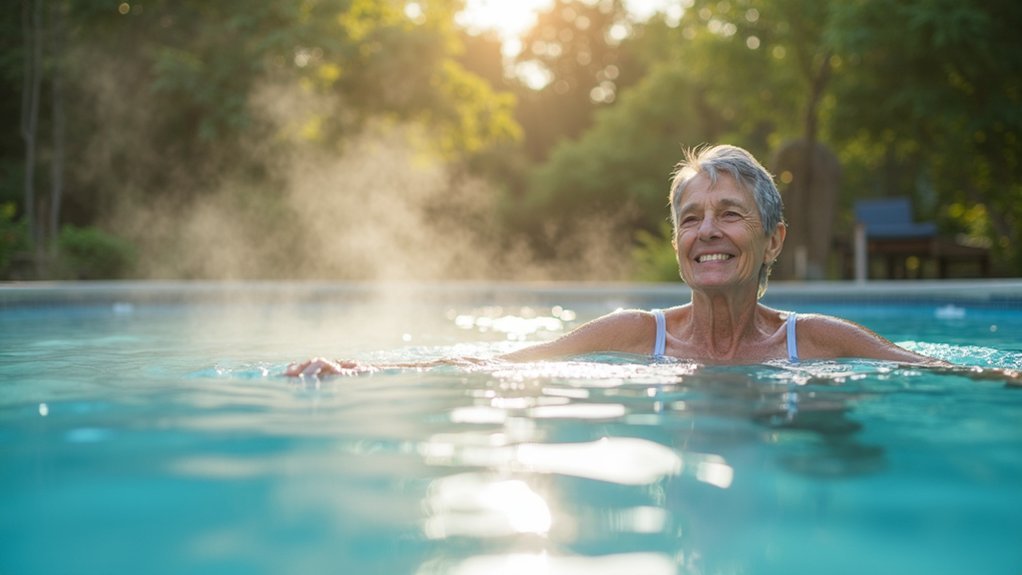
One of the most compelling advantages of water-based rehabilitation lies in its exceptional pain management capabilities. You’ll experience considerable relief through aquatic therapy’s gravity-free environment, which eliminates joint stress that typically exacerbates discomfort during knee rehabilitation. The warm water soothes your muscles while enhancing blood flow to promote healing.
| Pain Management Factor | Land-Based Therapy | Aquatic Therapy |
|---|---|---|
| Joint Stress Level | High impact | Gravity-free environment |
| Range of Motion | Limited by pain | Enhanced by buoyancy |
| Medication Reliance | Higher dependency | Reduced need |
| Pain Levels Reported | Standard baseline | Considerably lower |
Studies consistently show patients report reduced pain levels compared to traditional land-based approaches. Water’s buoyancy enables you to perform movements that would be too painful on land, while regular sessions decrease your reliance on pain medications post-surgery.
Buoyancy Reduces Joint Pressure
Understanding the science behind buoyancy reveals why water creates such an ideal rehabilitation environment for your recovering knee.
When you’re submerged in water, buoyancy greatly decreases your body’s effective weight, dramatically reducing joint pressure on your healing knee. This natural support system allows you to move more freely without the gravitational load that normally stresses your replacement joint.
The reduced joint pressure enables you to begin rehabilitation activities earlier than traditional land-based therapy.
You’ll experience less pain and discomfort during exercises, making your recovery process more manageable.
Aquatic therapy takes advantage of this buoyancy effect, allowing you to perform strengthening and flexibility exercises that would otherwise be too painful or risky during your post-surgical recovery period.
Enhanced Range of Motion Through Water Resistance
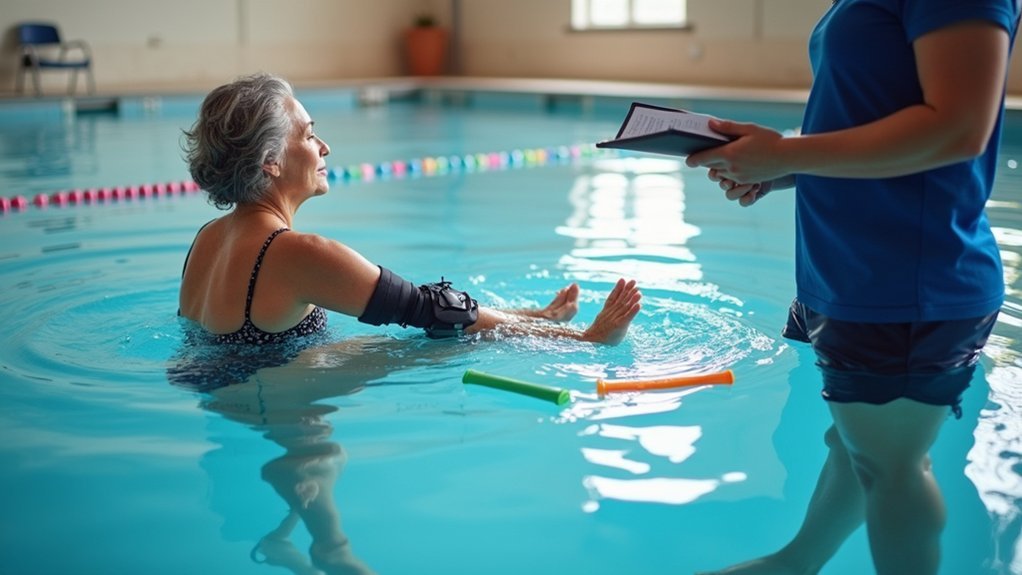
While buoyancy provides the foundation for pain-free movement, water’s resistance properties create the perfect training ground for rebuilding your knee’s range of motion.
Water therapy offers adjustable resistance that strengthens your muscles while improving flexibility. You’ll find this resistance naturally adapts to your movement speed and effort level, creating personalized rehabilitation.
Studies show patients who participate in aquatic therapy after knee replacement surgery achieve superior flexion and extension compared to traditional land-based programs.
Early initiation of water therapy greatly improves WOMAC scores for pain, stiffness, and physical function. You’ll experience less discomfort underwater, encouraging greater participation in exercises.
This increased willingness to move translates directly into improved range of motion and faster overall recovery progress.
Faster Recovery With Improved Circulation
Your circulation gets a significant boost when you participate in aquatic therapy after knee replacement surgery.
You’ll experience enhanced blood flow from warm water immersion, which dilates your blood vessels and delivers more oxygen and nutrients to healing tissues.
This improved circulation reduces swelling through better lymphatic drainage and accelerates your overall healing process.
Enhanced Blood Flow
After you undergo total knee replacement surgery, your body’s healing process depends heavily on efficient blood circulation to deliver oxygen and nutrients to damaged tissues. Aquatic therapy creates ideal conditions for enhanced blood flow through water’s unique properties.
| Water Property | Circulation Benefit | Recovery Impact |
|---|---|---|
| Hydrostatic pressure | Reduces swelling | Faster tissue healing |
| Warm temperature | Increases blood flow | Enhanced nutrient delivery |
| Buoyancy effect | Improves venous return | Reduced edema |
| Combined properties | Optimizes tissue perfusion | Accelerated recovery |
| Pressure gradient | Facilitates waste removal | Less pain/inflammation |
The hydrostatic pressure surrounding your knee replacement site acts like a natural compression garment, promoting circulation while water’s warmth dilates blood vessels. This enhanced blood flow delivers healing nutrients faster while removing metabolic waste products more efficiently, greatly reducing post-surgical inflammation and accelerating your recovery timeline.
Reduced Swelling Benefits
Because swelling represents one of the most challenging aspects of knee replacement recovery, water therapy’s anti-inflammatory effects become invaluable during your rehabilitation journey.
The buoyancy of water creates an ideal environment where you can exercise without placing excessive strain on your healing joint, allowing improved circulation while minimizing inflammation.
You’ll experience faster swelling reduction compared to traditional land-based rehabilitation methods.
Warm water therapy greatly decreases pain and edema, enhancing your overall mobility and comfort during recovery. The hydrostatic pressure naturally promotes blood flow, helping your body eliminate excess fluid more efficiently.
This enhanced circulation doesn’t just reduce swelling—it strengthens surrounding muscles, improving knee stability and function.
You’ll likely notice quicker edema reduction, creating a more effective rehabilitation timeline that gets you back to normal activities sooner.
Accelerated Healing Process
While your body works to heal from knee replacement surgery, water therapy’s hydrostatic pressure creates a powerful circulation boost that accelerates your recovery timeline.
This enhanced blood flow delivers essential oxygen and nutrients directly to healing tissues, speeding up cellular repair processes that would otherwise take weeks longer.
The warm water environment dilates your blood vessels, maximizing circulation throughout the surgical area.
You’ll experience faster tissue regeneration as increased blood flow removes metabolic waste products that can slow healing.
Studies consistently show patients using aquatic therapy achieve measurably quicker recovery milestones compared to traditional rehabilitation alone.
Water’s buoyancy lets you start moving sooner, promoting the circulation necessary for peak healing.
This earlier activity initiation means you’re actively supporting your body’s natural recovery mechanisms from day one post-knee replacement.
Building Strength Without Impact Stress
When you step into warm water for your post-surgery rehabilitation, buoyancy immediately reduces the weight-bearing load on your new knee joint by up to 90%. This dramatic reduction in impact stress allows you to perform essential muscle strengthening exercises without fear of aggravating your healing tissues.
Aquatic therapy leverages water’s natural resistance to build strength while protecting your knee replacement from jarring forces that land-based exercises create.
You’ll engage in underwater bicycling and treadmill walking, movements that’d typically stress your joints on dry land. Research demonstrates that patients experience improved hip abductor strength, which directly supports knee stability.
The warm water increases blood circulation while simultaneously relaxing your muscles, creating ideal conditions for safe, effective rehabilitation that accelerates your recovery timeline.
Early Mobilization in a Safe Environment
You’ll find that water therapy eliminates your fear of falling while you begin moving your new knee joint immediately after surgery.
The buoyant environment lets you start essential exercises without the anxiety that comes with land-based movement during your vulnerable recovery period.
You can begin pain-free rehabilitation right away, giving your knee the early mobilization it needs for ideal healing.
Reduced Fall Risk
As you begin your recovery journey after knee replacement surgery, water therapy offers an exceptionally safe environment for early mobilization that dramatically reduces your fall risk.
The buoyant properties of water support your body weight, allowing you to move freely without fear of weight-bearing on your recovering knee. You’ll experience enhanced confidence as warm water promotes muscle relaxation and improved circulation, making movements less painful than land-based activities.
Aquatic therapy enables effective strength training without traditional joint strain. Water’s natural resistance helps you build balance and stability safely while protecting your healing joint.
Studies demonstrate that patients report lower pain levels and greater mobility confidence, creating a positive cycle that further decreases fall risk and accelerates recovery timelines.
Immediate Post-Surgery Movement
While traditional rehabilitation often requires waiting days or weeks before beginning significant movement, water therapy enables you to start mobilizing immediately after your knee replacement surgery.
The buoyancy of water supports your body weight, dramatically reducing stress on your healing joint while allowing safe movement patterns essential for recovery.
Early mobilization through aquatic therapy prevents harmful scar tissue formation that can limit your future mobility.
You’ll experience significant pain relief as the water’s warmth and hydrostatic pressure work together to reduce inflammation and discomfort.
This comfortable environment lets you achieve greater range of motion than you’d manage on land, while water resistance gently strengthens your muscles without overwhelming your recovering knee.
Pain-Free Exercise Start
Within 24 to 48 hours after your knee replacement surgery, you can begin pain-free exercises in the water that would be impossible on dry land.
Aquatic therapy creates an ideal environment where water’s buoyancy dramatically reduces weight on your healing joint, allowing movement without the intense discomfort you’d experience during traditional rehabilitation methods.
The warm water soothes inflamed tissues while promoting enhanced blood circulation to accelerate healing.
You’ll discover that exercises requiring balance, gentle stretching, and early strengthening become manageable when water supports your body weight.
This pain-free exercise approach builds confidence in your movement abilities, eliminating fears of falling or causing additional injury.
Studies consistently show that patients starting aquatic therapy immediately post-knee replacement achieve faster range of motion recovery and superior long-term functional outcomes.
Research Results on Water-Based Recovery
Recent clinical studies demonstrate that water-based rehabilitation delivers measurable improvements for knee replacement patients.
When you participate in aquatic therapy following knee surgery, you’ll experience significant reductions in pain, stiffness, and improved function as measured by the WOMAC scale. Research shows these benefits sustain at six months post-rehabilitation, with effect sizes ranging from .22 to .39 for physical function improvements.
You’ll find that starting early aquatic therapy produces superior outcomes compared to conventional gym treatment. The buoyancy and warmth of water enhance muscle reinforcement while reducing pain, expediting your recovery process.
Beyond physical improvements, you’ll likely notice enhanced mood and increased socialization opportunities during your rehabilitation journey, making water-based recovery both effective and enjoyable.
Essential Exercises for Pool Rehabilitation
You’ll need to focus on three key exercise categories to maximize your pool rehabilitation after knee replacement surgery.
Range of motion exercises will help restore your knee’s flexibility and movement capacity in the supportive aquatic environment.
Strength building movements and balance training will then progressively challenge your muscles and coordination as you work toward full recovery.
Range of Motion Exercises
Since buoyancy reduces the weight-bearing stress on your healing knee, you’ll find that performing range of motion exercises in water allows for smoother, more comfortable movement than land-based therapy.
You can engage in underwater bicycling to strengthen your knee while minimizing impact on the joint. The warm water soothes sore muscles, making exercises more comfortable during recovery.
You’ll notice significant improvements in knee flexibility through specific aquatic therapy movements. Many patients enhance their knee extension and flexion, with some reporting improvements from 90 degrees to 100 degrees within one week.
Walking on an underwater treadmill provides resistance and support, allowing gradual progression while reducing fall risks and promoting mobility post-surgery.
Strength Building Movements
While range of motion exercises restore your knee’s flexibility, building strength in the surrounding muscles becomes equally important for long-term recovery success.
Aquatic therapy provides ideal conditions for strength-building movements after knee replacement surgery. Water’s natural resistance challenges your muscles without straining your healing joint.
You’ll perform underwater bicycling to target your quadriceps and hamstrings while improving circulation and reducing swelling.
Core stabilization exercises become manageable in water’s buoyant environment, strengthening essential abdominal and back muscles that support your recovery.
Walking or jogging on underwater treadmills offers low-impact endurance building.
Research confirms that resistance exercises in water considerably improve muscle strength, range of motion, and overall recovery outcomes following total knee replacement surgery.
Balance and Stability Training
After building strength in your knee’s supporting muscles, you’ll need to focus on balance and stability training to restore your body’s natural coordination and confidence in movement. Aquatic therapy’s buoyancy eliminates fall risks while you perform challenging stability exercises post-knee replacement.
| Exercise Type | Primary Benefit | Duration |
|---|---|---|
| Underwater Walking | Improves proprioception | 10-15 minutes |
| Single-Leg Stands | Enhances balance control | 30-60 seconds |
| Water Jogging | Builds coordination | 5-10 minutes |
| Treadmill Training | Restores gait patterns | 15-20 minutes |
| Side Steps | Strengthens stabilizers | 2-3 sets |
Water’s resistance strengthens your lower limb muscles while supporting proper movement patterns. Underwater treadmill training specifically targets gait improvements, rebuilding your walking confidence. Regular aquatic balance training produces measurable functional improvements, reducing pain while enhancing mobility outcomes.
Finding the Right Aquatic Therapy Program
How do you identify the ideal aquatic therapy program for your knee replacement recovery? Start by seeking facilities with HydroWorx pools featuring adjustable resistance therapy jets that customize your rehabilitation experience.
Your chosen aquatic program should offer a thorough rehabilitation protocol encompassing stretching, core stabilization, and cardiovascular activities for gradual recovery progression.
A comprehensive aquatic rehabilitation protocol must integrate stretching, core stabilization, and cardiovascular components to ensure optimal knee replacement recovery progression.
Prioritize programs providing individualized treatment plans tailored to your specific recovery goals and surgical needs. Verify that certified physical therapists specializing in aquatic therapy lead sessions, as their expertise directly impacts your outcomes and helps prevent compensatory movement patterns.
Research each program’s track record thoroughly. Patient testimonials reveal real experiences and indicate treatment effectiveness.
Successful aquatic therapy depends on finding qualified professionals who understand post-surgical rehabilitation requirements and can adapt exercises to your healing timeline and mobility limitations.
Frequently Asked Questions
Is Water Therapy Good After a Total Knee Replacement?
Yes, you’ll find water therapy excellent after total knee replacement. You’ll experience reduced pain and swelling while safely improving strength and flexibility. The buoyancy supports your knee, preventing falls during exercises.
What Is the Best Therapy After Total Knee Replacement?
You’ll find physical therapy’s the gold standard after total knee replacement. It’ll restore your range of motion, strengthen muscles, and improve function. Aquatic therapy’s particularly effective since water’s buoyancy reduces joint stress.
What Is Hydrotherapy for Knee Replacement?
Hydrotherapy for knee replacement involves exercising in warm water that supports your body weight. You’ll perform tailored movements that reduce joint stress while water’s resistance strengthens muscles and improves flexibility safely.
How Long After Surgery Can You Do Hydrotherapy?
You can typically start hydrotherapy as early as one week after knee replacement surgery, once your doctor clears you and your surgical site begins healing properly.
In Summary
You’ll accelerate your recovery by embracing water therapy after knee replacement surgery. You’re giving yourself the best chance at regaining mobility while minimizing pain and discomfort. Don’t overlook this powerful rehabilitation tool – it’s supported by solid research and offers unique benefits you can’t get from land-based therapy alone. You’ll move better, heal faster, and build confidence in your new knee when you incorporate aquatic therapy into your recovery plan.

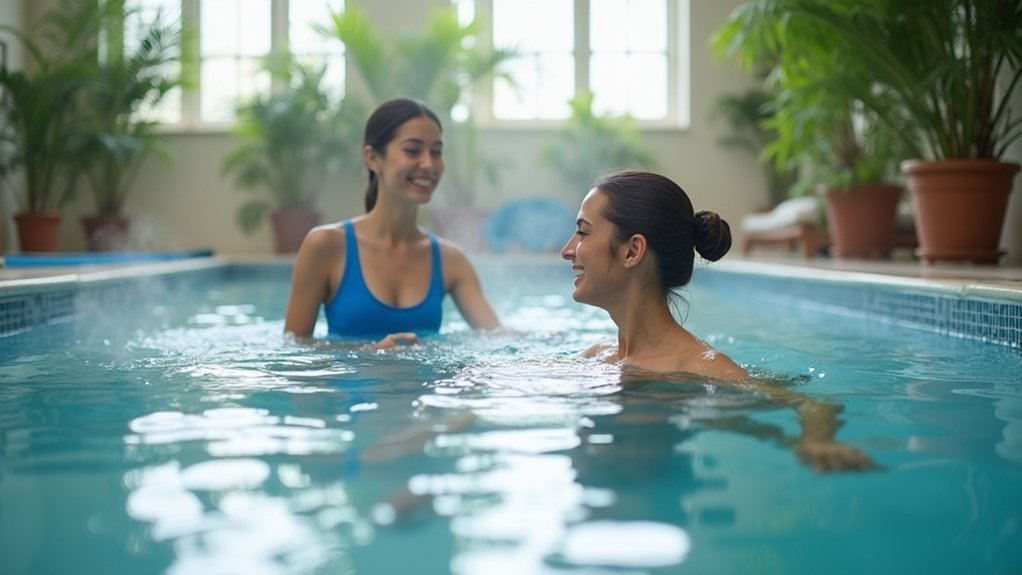

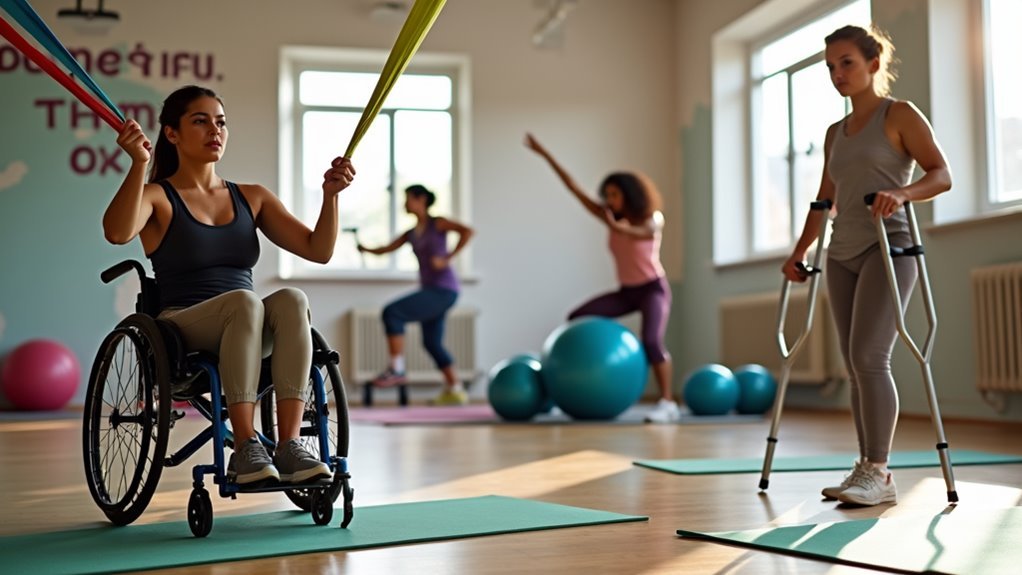
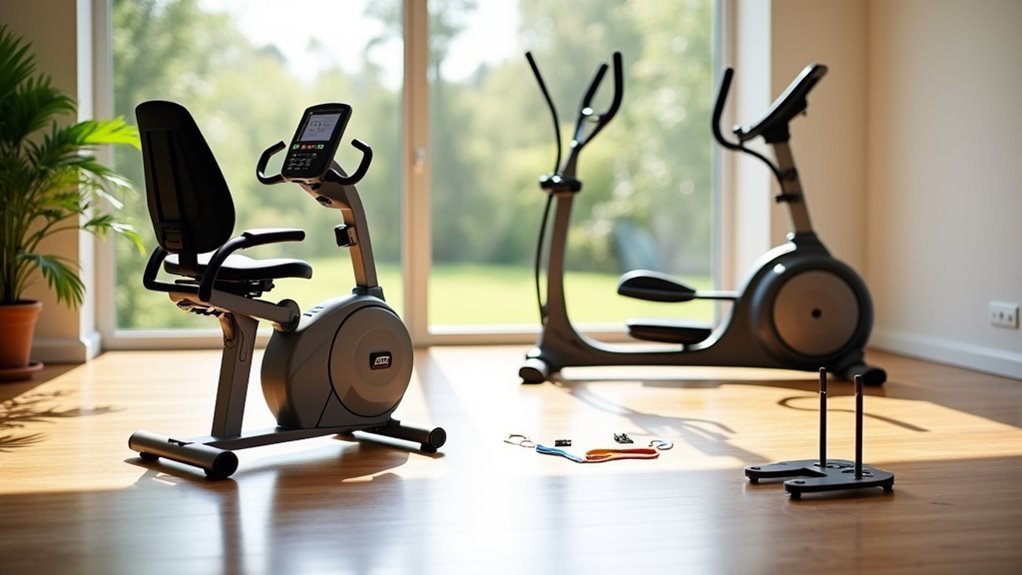
Leave a Reply